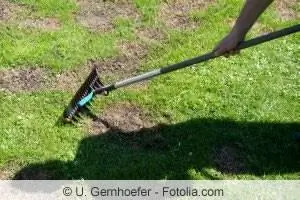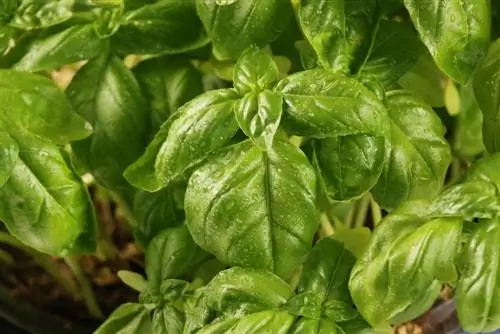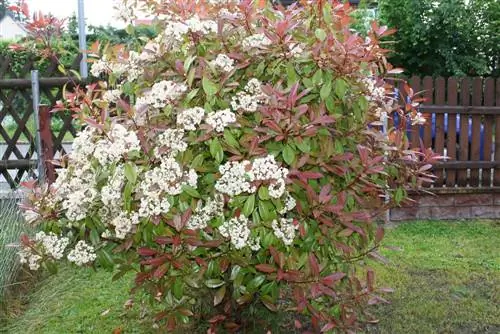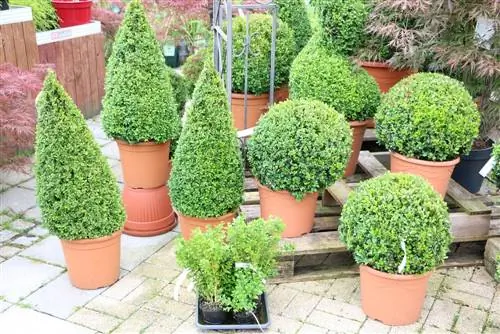- Author admin [email protected].
- Public 2023-12-17 03:39.
- Last modified 2025-01-24 12:45.
Is the holey, overused lawn a thorn in your side? Don't worry about this disruption to your garden, but take the initiative. Creating a new lawn is less complicated than expected. In addition, the entire budget for the hobby garden does not have to be used up to renovate a lawn. There are various procedures available to choose from. Patient gardeners choose the slow, inexpensive method of lawn seeding. If you want to invest a little more, choose the quick approach using rolled turf. Here's how to do it step by step.
Lawn renovation through reseeding
Hobby gardeners who want to replant an old lawn and consider the time factor to be of secondary importance use fresh lawn seeds. Ideally, the exact type of grass that was originally used is still known. If this is not the case, suitable reseeding mixtures are available from specialist retailers, tailored to the function of the grass area as play and sports turf or ornamental turf.
Tip:
The best time to replant an old lawn is the spring months from May to June. Alternatively, September can be considered for lawn renovation.
Mow low
The lawn is first mown as deep as possible. If the blades of grass are very high in spring, it is best to mow in two stages so that the lawn mower is not overused. The drier the grass area, the easier it is to cut by hand. The clippings are then completely removed.
Verticutting
In this step, thorough scarifying creates the optimal conditions for all further stages. The usual working depth of 3-5 millimeters does not meet the requirements in this case. If you are re-laying an old lawn, it is important to break up the turf so intensively that space is created for the absorption of effective active ingredients to improve the soil and for the lawn seeds. Only then will the desired homogeneous unity develop, which ultimately results in a lush green carpet of lawn. It is therefore recommended to use a professional scarifier, which can be rented from well-stocked rental shops or hardware stores.
- Scarify the mown lawn in two steps
- Work lengthwise and crosswise
- Rake off all loose plant parts and compost them
Soil improvement
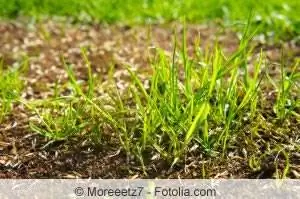
If there are any specific settlements in the old lawn, these can be easily recognized after scarifying. Now is the perfect opportunity to level this out with the help of a suitable filling floor. Then give the soil a few days to settle and possibly add some more soil. If the unevenness can be traced back to the disastrous work of moles or voles, we recommend scaring them away or fighting them off as an intermediate step. Even though the burrowers are away for a few days as part of the renovation work, they are guaranteed to return as soon as things calm down. Where this interlude can be skipped, enriching the old turf with soil additives is now on the agenda. If the grass area suffered from compacted soil, a layer of sand now provides the necessary loosening with a maximum dosage of 3 liters per square meter. In contrast, you can enrich silted lawn soil with clay powder. Mature compost, which you apply in a 1 centimeter thick layer - i.e. 10 liters per square meter - with the sand, has a revitalizing effect on the stressed lawn.
- Work compost and sand or clay powder into the soil with a rake
- Work in a layer of soil additives of more than 10 millimeters using the scarifier
If the soil is so compacted that more sand is required, you cannot avoid breaking up the soil and then leveling it.
Tip:
To compensate for soil settlement, use a filling soil with a similar structure to the previous one. Excessive physical differences later cause an inhomogeneous appearance because the lawn seeds develop differently.
Fertilizing and sowing
Now a phosphorus-concentrated starter fertilizer is used, which is administered before sowing the lawn. A spreader ensures even distribution. Ideally, you should apply the fertilizer lengthwise while the lawn seeds are spread crosswise. This little trick effectively prevents false scattering.
Cover
In order to enable the lawn seeds to germinate well in the soil, finally cover the seeds with a lean substrate, such as peat. This top layer must not be applied higher than 0.5 centimeters. In this way, sufficient light reaches the seeds while at the same time protecting them from being washed away.
Rolling and sprinkling
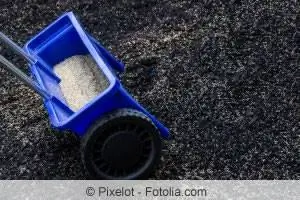
If a lawn roller is available, this provides additional stabilization of the seed. The renovated lawn is then intensively watered.
- Do not water newly planted lawns under the blazing sun
- Wrinkle every 2 days during the first 14 days after sowing
- Mow for the first time from a height of 8-10 centimeters
Easily re-lay old lawn with the turf sandwich method
Sowing lawn always requires a lot of patience from the hobby gardener until the longed-for, lush green carpet appears. Renovating an old grassy area is much quicker using rolled turf. Thanks to the innovative sandwich method, there is no need to peel off the used sod. The turf is laid on the old grass, which quickly decomposes underneath and turns into a nutrient-rich layer for soil organisms. Here's how to do it step by step:
Mowing super short
Since nothing more is expected from the grass roots of the old lawn, mow the area as short as possible. No measures are required against the weeds in it, such as scarifying or even using a herbicide. As extensive tests have shown, the turf that follows later gives weeds no chance to develop.
Compensate unevenness
The smoother the surface, the more even the new appearance of your lawn will be. It is therefore worth investing a little effort in creating the fine subgrade with a fine crumbly soil structure.
- Straighten the mown lawn with topsoil
- Alternatively, apply a compost-sand mixture
- Smooth with a rake
Tip:
The first two work steps are carried out, if possible, the day before the turf is delivered. Since freshly peeled turf dries out very quickly, it can be processed within 12-24 hours.
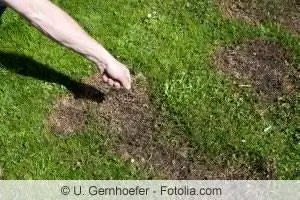
Fertilizing and laying
Before you start laying the turf, apply a suitable starting fertilizer to the old lawn area. As with sowing, a phosphate-based fertilizer is beneficial. Then proceed as follows:
- Laying begins along a straight edge
- Place the lawn rolls end to end
- Laying at an offset is ideal, like when bricking walls
- Do not leave any joints or gaps
- Cut the edge with a sharp knife
- Last but not least, roll the lawn lengthwise and crosswise
Lay the lawn so that you don't have to walk on it if possible. If this is unavoidable, place wooden slats there. If you are using the lawn roller, you only step on the already compacted grass areas. It may be necessary to rework fixed lawn edges. Since rolled turf is 2 to 3 centimeters high, it is necessary to compensate for bed borders, terraces or garden paths.
Water
On the day turf is laid, it must be watered thoroughly. When the grass area is no longer in direct sunlight in the evening, leave the tap running until every square meter has been soaked with 10 to 15 liters. After this rejuvenation treatment, the old lawn is beautiful to look at from day one. In order to carry out regular watering in the following weeks, turf can easily be walked on to set up the lawn sprinkler. You should only expose the grass area to the stress of a barbecue party after 4 weeks at the earliest.
Care for turf properly
If your old lawn shines in a new, fresh green color, the weather determines the first mowing pass. Experience has shown that after 7 to 14 days, the new lawn has grown to the point where it requires a lawn mower. If intensive irrigation is still taking place at this point, it will initially be reduced. Once the surface has dried, proceed as follows:
- Don't trample the blades of grass in advance
- Cut the lawn by a maximum of a third
- The optimal stalk height is 4 to 6 centimeters
- Never mow under the blazing sun
- After a rain shower, let the surface dry first
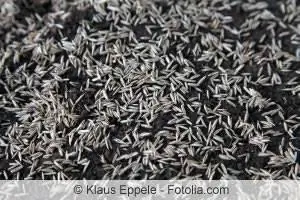
When laying the turf, nutrients are supplied that are sufficient for the next 4 to 6 weeks. Then apply a high-quality long-term fertilizer. Apply a nitrogen-rich preparation as a starter fertilizer in March/April at seasonal intervals. For summer fertilization, a long-term fertilizer is indicated in mid/late June. It is also advisable to prepare the lawn for the rigors of the winter at the end of August with a potassium-based fertilizer.
Conclusion
Sooner or later, every lawn gets old and leaves something to be desired in appearance. The more intensively the grass area is used or in view of cumulative soil problems, the entire garden suffers from the disadvantage of a weak lawn. It's a good thing that renovating a lawn is effortless. There is no need for complex breaking or leveling work. Instead, deep mowing, scarifying and reseeding are carried out. If necessary, take the opportunity to correct the soil problems through improvement measures. You can re-lay an old lawn even faster with rolled turf using the innovative sandwich method. If you follow the understandable step-by-step instructions, you will quickly recognize the uncomplicated procedure and no longer have to worry about an unattractive, old lawn.

